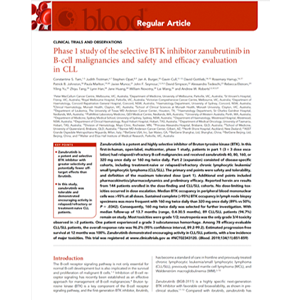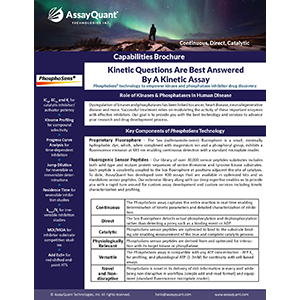A Continuous Assay Format That Enables Easy Identification and Analysis of Time-Dependent Kinase Inhibitors In Your Lab
Powered by PhosphoSens® technology.
Interest in time-dependent inhibition from today's kinase and drug discovery research has led to the need for a continuous assay format to replace its end-point counterpart. While the end-point format has been used historically to determine inhibitor potency, this format has significant disadvantages in studies involving time-dependent inhibition. In particular, an end-point analysis assumes that the initial reaction rate is maintained throughout the forward progress curve. Thus, lags at the beginning and/or saturation towards the end of the curve are not captured.
PhosphoSens Technology enables deep kinetic quantification of a compound's time-dependent inhibition with a simple set of experiments. Let’s call it DIY-TDI!
All you need is a PhosphoSens sensor peptide for your kinase, a standard fluorescence plate reader and the simple workflow outline below:
1. Inhibitor Characterization
Inhibitor potency curve +/- pre-incubation with enzyme.
- This identifies the presence or absence of TDI
- For Time Dependent Inhibitors: A non-linear progress curve is observed, and a working compound concentration range for the next steps in the TDI workflow is determined
- For Non-Time Dependent Inhibitors: A linear progress curve is observed and compound potency via IC50 is determined
2. Reversibility Determination
Inhibitor dose-response curve pre-incubated with enzyme followed by a 100X Jump dilution.
- Determination of reversible or irreversible time-dependent inhibition
- Reversible inhibitors: Reaction rate recovers following Jump Dilution
- Irreversible inhibitors: Reaction rate does not recover following Jump Dilution
3. TDI Characterization (Reversible or Irreversible)
For inhibitors displaying Reversible Inhibition: Jump dilution method including jumps ranging from 5x to 100x. For inhibitors displaying Irreversible Inhibition: Inhibitor dose-response curve at 1.5 inhibitor dilution series and best-fit global analysis.
- For inhibitors displaying Reversible Inhibition: Residence time (tau), koff and half-life are determined
- For inhibitors displaying Irreversible Inhibition: kinact/KI is determined
Time-Dependent Inhibition Workflow Using AssayQuant's PhophoSens Continuous Assay Technology
In the presentation, we walk you through our TDI (time-dependent inhibition) workflow, which includes:
- Determination of the presence/absence of time-dependent inhibition
- If time-dependent, determine reversibility/irreversibility
- Quantitative characterization of the reversible or irreversible inhibition
And we'll show you how this workflow yields the kinetic parameters that are of greatest interest to research and drug discovery.
Presentation Includes:
- PhosphoSens Technology overview enabling a continuous assay format
- Comparison of continuous and end-point assays
- Introduction to time-dependent inhibition (TDI)
- PhosphoSens workflow for TDI
- Determination of reversible/irreversible inhibitor binding
- Reversible inhibitor characterization:
- koff (off-rate)
- t1/2 (half-life)
- τ (tau, residence time)
- Irreversible inhibitor characterization:
- kinact (max rate of inactivation)
- KI (kinetic binding constant)
- kinact/KI (inactivation efficiency)
- When to report IC50, and when to report kinact/KI

Earl May, Ph.D., Senior Director of Discovery Technologies
Earl has 25+ years of expertise in drug discovery and enzymology from GSK, OSI and several other biotechnology companies. He has used our Sox sensor peptide technology at all companies he had kinase inhibitor programs, with both reversible and covalent compounds.Additional Download
Access a PDF version of the presentation above.
♦ IC50, EC50 and Ki for catalytic inhibitor/activator potency ♦ Kinome Profiling for compound selectivity ♦ Progress Curve Analysis for time-dependent inhibition ♦ Jump Dilution for reversible vs irreversible determinations ♦ Residence Time for reversible inhibition studies ♦ kinact/KI for irreversible inhibition studies ♦ MOI/MOA for inhibitor-substrate competition studies ♦ Add Eu3+ for red-shifted endpoint HTS ♦
Find Your Next Kinetic Assay Kit
PhosphoSens continuous assays deliver kinetic answers to kinetic questions, with a simple format and superior substrates to streamline workflows and enable new discoveries. With hundreds of assays developed and a robust assay development process, AssayQuant is a leader in next-generation continuous assays.


